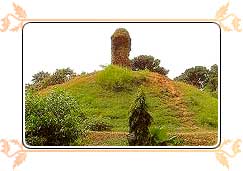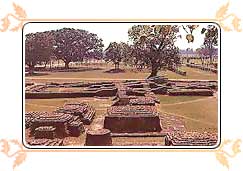 Lumbini (the sacred birthplace of Buddha)- a
place in the South-Western Terai of Nepal, evokes a kind of holy sentiment
to the millions of Buddhists all over the world-as do the Jerusalem to
Christians and Mecca to Muslims. Lumbini is the place Lord Buddha -the
apostle of peace and the light of Asia was born in 623 B.C. Located in the
flat plains of south-Western Nepal and the foothills of Churia range ,
Lumbini and its surrounding area is endowed with a rich natural setting of
domesticable fauna and favourable agricultural environ. Historically, the
region is an exquisite treasure-trove of ancient ruins and antiquities,
dating back to pre-Christian era. The site, described as a beautiful garden
in the Buddha's time still retain its legendary charm and beauty and has some really fascinating pictures of Buddha. To the
mere 12 miles north of Lumbini lies the dense and picturesque sal-grove.
Lumbini (the sacred birthplace of Buddha)- a
place in the South-Western Terai of Nepal, evokes a kind of holy sentiment
to the millions of Buddhists all over the world-as do the Jerusalem to
Christians and Mecca to Muslims. Lumbini is the place Lord Buddha -the
apostle of peace and the light of Asia was born in 623 B.C. Located in the
flat plains of south-Western Nepal and the foothills of Churia range ,
Lumbini and its surrounding area is endowed with a rich natural setting of
domesticable fauna and favourable agricultural environ. Historically, the
region is an exquisite treasure-trove of ancient ruins and antiquities,
dating back to pre-Christian era. The site, described as a beautiful garden
in the Buddha's time still retain its legendary charm and beauty and has some really fascinating pictures of Buddha. To the
mere 12 miles north of Lumbini lies the dense and picturesque sal-grove.History of Lumbini
For centuries, Buddhists- all over the world, knew that Lumbini (Buddha birthplace) where the Lord was born is somewhere around. The descriptions of famous Chinese pilgrims (of ancient times) Huian Tsang and Faeihan indicated to this area-saying 'Lumbini-where the lord was born is a piece of heaven on earth and one could see the snowy mountains amidst a splendid garden-embedded with stupas and monasteries (here they were talking about the beautiful Lumbini gardens)!
However, the exact location remained uncertain and obscure till December the 1st 1886 when a wandering German archaeologist Dr. Alois A. Fuhrer came across a stone pillar and ascertained beyond doubt it is indeed the birthplace of Lord Buddha.
Where Is Lumbini
Lumbini temple is situated at the foothills of the Himalayas in northern Nepal. In the Buddha's time, Lumbini was a beautiful garden (or we say Lumbini park) full of green and shady Sal trees (Shorea). The garden and its tranquil environs were owned by both the Shakyas and Kolias clans. King Suddhodana, father of Gautama Buddha was of the Shakya dynasty belonging to the Kshatriya or the warrior caste.
Pilgrimage
Attractions of Lumbini Tour
- The Ashokan Pillar
Discovered by the now famous German archaeolgist Dr. Fuhrer, the pillar is the first epigraphic evidence relating to the life history of Lord Buddha and is also the most visible landmark of the garden. The historic importance of the pillar is evidenced by the inscription engraved in the pillar (in Brahmi script). It is said that the great Indian Emperor Ashok visited the site in the twentieth year of is ascendancy to the throne and as a homage to the birthplace,erected the pillar.
The inscriptions in the pillar roughly translates as: Kin Piyadesi beloved of th Gods, having been anointed 20 yeas, came himself and worshipped saying Here Buddha Shakyamuni was born: And he caused to make a stone (capital) representing a horse; and he caused (this) stone pillar to be erected. Because the worshipful one was born in the village of Lumbini has been made free of taxes and recipient of wealth". - Puskarni - The Sacred Pool
South of the Ashokan Pillar, there is the famous sacred pool- 'Puskarni' believed to be the same sacred pool in which Maya Devi took a holy dip just before giving birth to the Lord and also where infant Buddha was given his first purification bath. Architecturally the pool has the projecting terraces in descending order and is reverted with a fine brick masonry. - Sanctum-Sanctorum of the Birthplace
The single most important place of the Lumbini (and to the entire Buddhist world for that matter) is the stoneslab-located deep in the Sanctum sanctorum. Revealed after a hard and meticulous excavations under the three layers of ruins over the site of a famous Maya Devi temple, the stone slab foundation pinpoints the location of the original place-marking the exact spot of the birthplace of Lord Buddha. - Image of Maya Devi
In adition to Ashokan Pillar, the other Shrine of importance is the bas-relief image of Maya Devi, Enshrined in a small pagoda-like structure, the image shows MayaDevi , mother of the Lord. Supporting herself by holding on with her right hand to a branch of Sal tree, with newly born infant Buddha standing upright on a lotus pedestal on an oval halo. Two other celestial figures are depicted in an act of pouring water and lotuses bestowed from heaven.
 Earlier
the image was placed in the famous white temple of MayaDevi beside
the pillar-now totally dismantled to make way for the excavations,
which revealed the Sanctum Sanctorum the exact spot where the Lord
was born.
Earlier
the image was placed in the famous white temple of MayaDevi beside
the pillar-now totally dismantled to make way for the excavations,
which revealed the Sanctum Sanctorum the exact spot where the Lord
was born. - The Buddhist Temple
The monastery-of the Buddhist temple is built inside the surrounding complex of Lumbini in the manner of modern Buddhist shrines in Nepal. The prayer hall contains a large image of Buddha. medieval style murals decorate the walls.